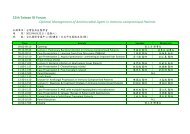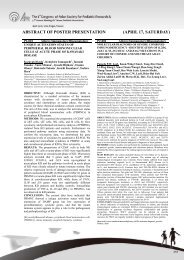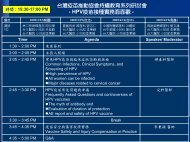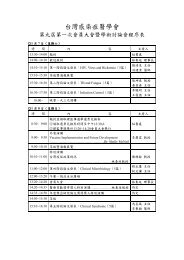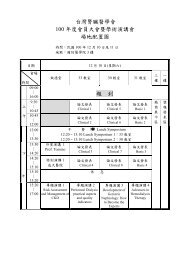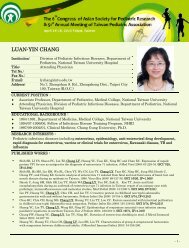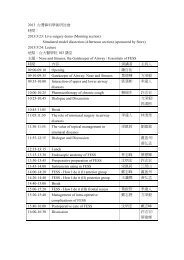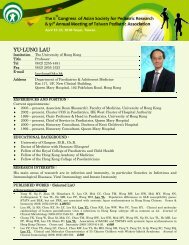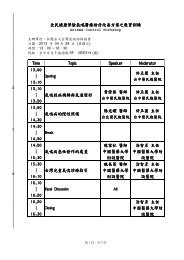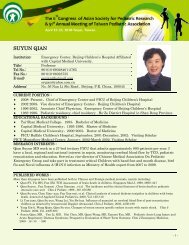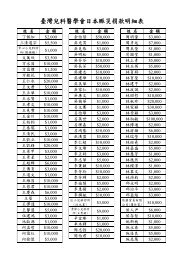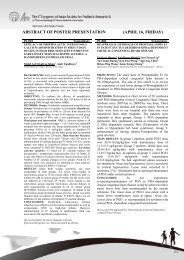ABSTRACT OF INVITED LECTURES AND ORAL PRESENTATION
ABSTRACT OF INVITED LECTURES AND ORAL PRESENTATION
ABSTRACT OF INVITED LECTURES AND ORAL PRESENTATION
- No tags were found...
Create successful ePaper yourself
Turn your PDF publications into a flip-book with our unique Google optimized e-Paper software.
FP4-05FACTORS ASSOCIATED WITH DEATHAMONG UNDER-FIVE CHILDREN WITHPNEUMONIA IN AN URBAN DIARRHOEATREATMENT CENTRE, DHAKA,BANGLADESHMohammod Jobayer Chisti 1 2 , Mohammed AbdusSalam 1 , Pradip Kumar Bardhan 1 , Tahmeed Ahmed 1 ,Abu Syed Golam Faruque 1 , Sophie La Vincente 2 4 ,Colin F Robertson 3 4 , Trevor Duke 2 41 Clinical Sciences Division (CSD), International Centre for DiarrhoealDisease Research, Bangladesh (ICDDR,B); 2 Centre for International ChildHealth (CICH), Royal Children’s Hospital, Department of Paediatrics, TheUniversity of Melbourne; 3 Respiratory Medicine, Royal Children’s Hospital,Department of Paediatrics, The University of Melbourne 4 MurdochChildren’s Research Institute (MCRI)OBJECTIVES: To evaluate the clinical and thesocio-demographic predictors of deaths from pneumoniaamong under-five children with diarrhoea.METHODS: We prospectively enrolled all children youngerthan 5 years who were admitted to the Special Care Unit(SCU) of the Dhaka Hospital of ICDDR,B with pneumoniaalong with diarrhoea during September through December2007. Pneumonia was diagnosed according to WHOguidelines for acute respiratory infection (ARI). Treatmentinvolved giving oxygen if oxygen saturation was poor,broad-spectrum antibiotics as per the hospital protocol,intravenous or oral rehydration fluids if dehydrated or inshock, and diet. Out of the total 198 children enrolled,characteristics of children with fatal outcome (n=24) werecompared with those who survived (n=174).MAIN RESULTS: In univariate analysis the risk factors fordeath in children with pneumonia were: kwashiorkor (25% vs.10%; p = 0.04), clinical sepsis (79% vs. 49%; p = 0.010), poorperipheral perfusion as indicated by uncountable/absent radialpulse (29% vs. 7%; p = 0.003), low systolic (62.0 ± 41.0 vs.98.4 ± 28.4: p = 0.001) and diastolic (27.5 ± 21.9 vs. 56.7 ±19.4: p < 0.001) blood pressure (mm of Hg), low SPO2 (%)on admission (80.0 ± 12.0 vs. 89.1 ± 10.0: p = 0.001),immature neutrophils (%) in the peripheral blood [0.0 (0.0,2.0) vs. 0. 0 (0.0, 0.0): p = 0.031], and renal failure asindicated by median (interquartile range) value of serumcreatinine (micromol/L) [156.5 (119.3, 264.3) vs. 75.0 (67.1,116.3): p = 0.026]. However, after adjusting for thecovariates by logistic regression, risk factors for a fataloutcome were severely underweight (OR 5.17, CI 1.21-22.02,p = 0.026), hypoxaemia (OR 17.52, CI 1.92-159.97, p =0.011), severe sepsis (OR 8.68, CI 1.81-41.52, p = 0.007) andlobar consolidation (OR 11.90, CI 2.30-61.58, p = 0.003).Metabolic acidosis was less common (OR 0.85, CI 0.75-0.97,p = 0.012).CONCLUSION: Our study identified severe malnutrition,hypoxaemia, severe sepsis, and lobar consolidation asindependent factors for deaths among children admitted withdiarrhoea and co-existent pneumonia. Identification of thesefactors and initiation of their appropriate managment couldhelp to prevent deaths among such children.[Keywords]Children; diarrhoea; death; hypoxaemia;pneumonia; under nutritionFP4-06EFFICACY <strong>OF</strong> INTRATRACHEAL ADMINISTRATION<strong>OF</strong> MEROPENEM IN AN ANIMAL MODEL <strong>OF</strong> ACUTELUNG INJURYMei-Jy Jeng, Wen-Jue Soong, Pei-Chen Tsao, Chia-FengYang, Shih-Yun Chiu, Yu-Sheng Lee, Ran-Bin TangInstitute of Emergency and Critical Care Medicine, School of Medicine, NationalYang-Ming University; and Department of Pediatrics, Children’s Medical Center,Taipei Veterans General Hospital, Taipei, TaiwanOBJECTIVE: To evaluate the efficacy of intratrachealadministration of meropenem using perfluorochemical (PFC) asa drug vehicle in an animal model of acute lung injury.METHODS: Eighteen newborn piglets were anesthetized,ventilated, injured with repeated saline lung lavage to induceacute lung injury, and grouped randomly into one of three studygroups: (1)Intravenous (IV) group (n = 6): intravenous injectionwith meropenem (20 mg/kg); (2)Intratracheal PFC (IT-PFC)group (n = 6): intratracheal instillation with the mixture of PFC(PP4, F2 Chemicals, 10 mL/kg) and meropenem (20 mg/kg);(3) Intratracheal normal saline (IT-NS) group: intratrachealinstillation with the mixture of saline (10 mL/kg) andmeropenem (20 mg/kg). Blood samples were obtained at 0, 15,30, 60, 120, 180, 240, 300, and 360 min for checking serumlevels of meropenem and arterial blood gas analysis. Lungtissues were obtained for testing meropenem contents afterexperiments. Peak inspiratory pressure (PIP) and lungcompliance (C L ) were also checked every 30 min.MAIN RESULTS: Animals of IV group showed the highestserum levels of meropenem (15 min: 17.8 μg/mL, 60 min: 7.7μg/mL, 360 min: 0.6 μg/mL), and animals of IT-PFC and IT-NSgroups had similar serum meropenem concentrations: (IT-PFC:15 min: 5.6μg/mL , 60 min: 4.8 μg/mL , 360 min: 0.3 μg/mL ;IT-NS group: 15 min: 6.2 μg/mL, 60 min: 5.5 μg/mL, 360 min:0.6 μg/mL ). The meropenem contents in lung tissue werehighest in IT-PFC group (1.25 ± 0.90 μg/g tissue at thedependent site and 0.23 ± 0.16 μg/g tissue at the non-dependentsite, but they are all undetectable in IT-NS and IV group. Inaddition, animals of IT-NS group had the highest PIP andlowest C L during the experimental 4h. During the experiments,there was no significant difference in the blood gas changesamong the three study groups.CONCLUSION: Intratracheally instilling the mixture ofmeropenem and PFC or normal saline is a safe way toadminister the antibiotics to injured lungs. The use of PFCliquid to carry meropenem into the lungs provides better drugdepositions than intravenous injection or intratrachealinstillation with saline. Therefore, the technique of intratrachealinstillation of meropenem and PFC liquid may be an effectiveway to treat patients with meropenem sensitive pulmonaryinfections in acute lung injury in the future.[Keywords]acute lung injury, intratracheal administration, meropenem,perfluorochemical74



